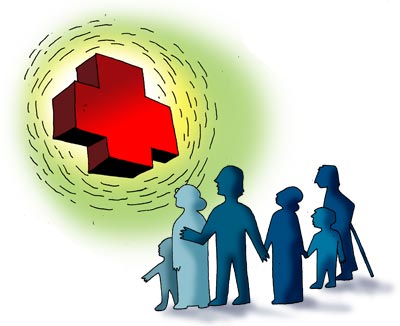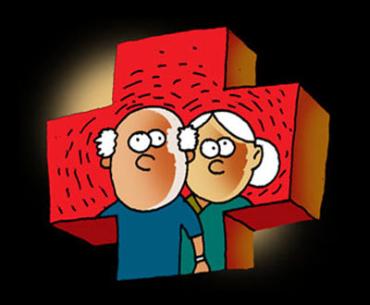 | « Back to article | Print this article |
How to address India's healthcare disaster
There has been a chorus of protest over the finance minister's proposal to impose a 5 per cent service tax on centrally air-conditioned hospitals that have more than 25 beds.
One deviant result (mimicking what used to happen in industry when small-scale reservation ruled) could be that larger hospitals get split into units of 24-bed facilities!
Meanwhile, a well-regarded surgeon like Devi Shetty of Narayana Hridulaya has proposed that March 12 be observed as Misery Day, to protest against the 'Misery Tax'.
The protestors miss the point, and the finance minister should answer them by promising that revenue collected from the tax will fund public hospitals -- a repeat of the education cess.
Click NEXT to read on . . .
How to address India's healthcare disaster
The real healthcare issue in India is that there is so little that is publicly funded. India is almost unique in that public funding of healthcare is only a fourth or fifth of the total; the rest comes from private resources.
This means that most families, which suffer the misfortune of a major illness get pushed into poverty by the medical bills; land and other assets are sold, debt incurred. The financial misery is often greater than the medical one.
Contrast this with what happens in civilised societies, where public hospitals (and indeed publicly-funded primary and secondary care) are a real option -- and not the over-crowded, under-provided places to avoid that India's government hospitals have become.
Click NEXT to read on . . .
How to address India's healthcare disaster
The disaster in India has been that, for the last quarter century, attention has been focused overwhelmingly on corporate hospitals, with the government adopting the insurance-driven model that has bankrupted the US economy -- which spends a record one-sixth of its GDP on healthcare, but has a worse health record than any other affluent society.
The scandal associated with this disaster in India is that doctors get patients to undergo needless tests, merely in order to use equipment and run up bills; the doctors get a commission on the tests and surgical procedures that are done.
Click NEXT to read on . . .
How to address India's healthcare disaster
People who run corporate hospitals confess that it is difficult to get doctors without offering such commissions.
It is not too late to bring about change. A committee in the Planning Commission has woken up and pointed out that copying the US healthcare model will not work; that a universal, publicly-funded healthcare infrastructure is needed.
This is saying the obvious, but all too often the obvious is not even considered an option. India has to double and treble its public expenditure on healthcare, in the same way that its investment in infrastructure has multiplied.
Click NEXT to read on . . .
How to address India's healthcare disaster
Healthcare has to receive the same attention that education has begun to receive.
Some state governments have experimented with a medical insurance programme where the premium is paid by the state and healthcare bills are reimbursed to private hospitals.
Anecdotal evidence suggests that this has fallen prey to bogus bills and false medical histories. Also, the public-private partnership model in which the government provides free land in exchange for concessional treatment for the poor by a private hospital, has been abused repeatedly; the poor rarely benefit.
Click NEXT to read on . . .
How to address India's healthcare disaster
The fact is that it costs less than Rs 100 crore (Rs 1 billion) to set up a 300-bed hospital, and there is no reason why every district should not get a new one every year; the capital cost for 600 districts would be less than 1 per cent of GDP.
Over five years, you could set up one in every tehsil or block -- and effectively double the number of hospital beds in the country.
Simultaneously, medical education would have to be expanded post-haste. This is the minimum that should be done in the India of 2011.






